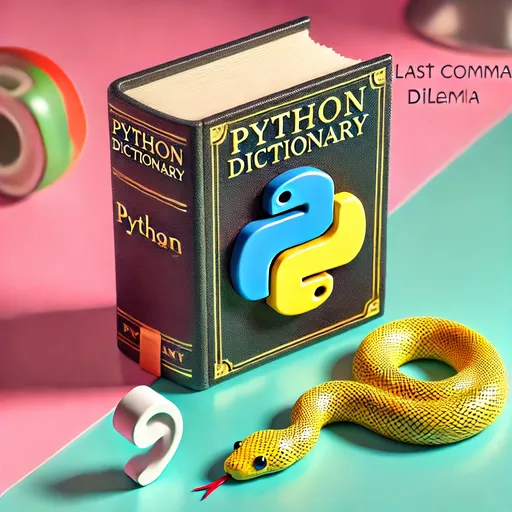In the world of programming, I believe that syntax is akin to order. However, when that order is too flexible, it can often leave you scratching your head. I feel this truth every time I use JavaScript.
JS feels like a language with a free spirit. There's no need for type declarations, variable scoping can be confusing, and even function calling syntax sometimes feels ambiguous. Yet, because it's an unavoidable tool for frontend development, JS is truly a love-hate relationship for me.
In contrast, Python offers a much clearer and more structured syntax. However, there are still aspects in Python that can be a bit bothersome. One of them is the trailing comma issue in dictionaries.
The Truth About Trailing Commas in Python Dictionaries
When defining a dictionary in Python, should you include a comma (,) after the last key: value pair, or omit it? I wanted to find out what is syntactically more correct.
In conclusion, it works whether you include the comma or not. However, Python developers who follow PEP 8 style guidelines often recommend including trailing commas. This improves readability, especially in multi-line dictionaries, and makes it easier to add new items later.
For example:
my_dict = {
'name': 'Alice',
'age': 25,
}Adding a comma at the end like this is preferred in the Python community as it makes the code look cleaner. However, when written in a single line, it's common to omit the comma:
my_dict = {'name': 'Alice', 'age': 25}
This small difference can significantly impact consistency and readability when writing and reading code.
Finding a Dictionary in C++: std::map and std::unordered_map
As I was talking about this, I thought of C++ as well. C++ has key-value stores that are similar to Python's dictionary: std::map and std::unordered_map. They both store keys and values in pairs, but there are slight differences.
std::map: Keys are stored in sorted order. It is efficient for search and insertion, having logarithmic time complexity.std::unordered_map: Based on a hash table, the storage order is not guaranteed, but it provides fast search capabilities with constant time complexity.
Here's an example of initialization:
#include <map>
#include <iostream>
int main() {
std::map<std::string, int> my_map = {
{"Alice", 25},
{"Bob", 30}
};
for (const auto& pair : my_map) {
std::cout << pair.first << ": " << pair.second << std::endl;
}
return 0;
}Unlike Python, in C++ you must explicitly specify the types of keys and values. This rigor reflects C++'s emphasis on type safety. Having such clear rules gives me a sense of comfort while using C++.
In Conclusion
Programming languages each possess their own philosophies and characteristics. JS, with its free spirit; Python, which emphasizes rules; and C++, which prioritizes type safety. As developers, our role is to find a balance between syntactical flexibility and strictness while navigating these diverse languages.
So today, I momentarily set aside my concerns about syntax and remind myself of the joy that coding brings, placing my hands back on the keyboard. What language do you have a love-hate relationship with?

There are no comments.